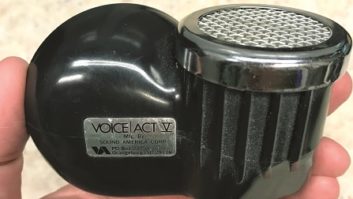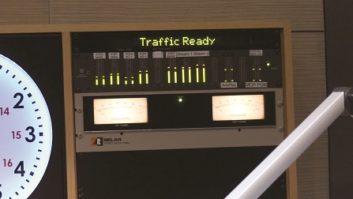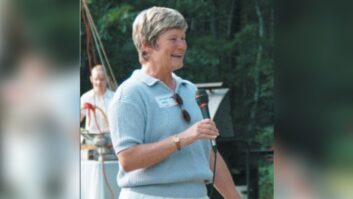Field Report: Comrex Matrix
Feb 1, 2001 12:00 PM, By John Diamantis
Transmitting audio via telephone circuits has been a necessity inradio for quite some time. In the beginning, radio used plain oldtelephone service and a plain old telephone. It was fast, cheap, easy,and sounded awful. The next step up was conditioned, or equalized,lines. This worked fine while the phone company had technicians thatknew how to set them up and they cost only $125 to install. If you caneven get one today, install prices are about $1,500 to $2,500 for asingle line. Not very cost effective for a quick remote from the localDonut Hut.
Our stations, WBQB and WFVA, are remote intensive, especially duringthe spring and summer. Although we have a well-equipped broadcast van,complete with pneumatic mast and remote pickup equipment (RPU), thereare times and situations where RF remote gear is impractical. RPUequipment is good for short-range work, but interference is a constantproblem, especially in metro areas. It also requires a crew with thetechnical savvy to operate the equipment. Plus, it’s often tough to geta clean signal out of malls and other large venues.
Performance at a glance
- Uses standard POTS lines
- Full-duplex 15kHz audio
- Easy to learn and use
- Built-in mixer
- Up to 7 hours operation on battery
- Clear, concise manual
With our stations’ desire to do remotes beyond the range of ourcurrent RPU system, I wanted a device that could be setup easily, giveus excellent audio quality, and minimize operational cost. After someinvestigating, I decided to try one of the POTS codecs. Our FM stationhad a contest coming up that required a live remote broadcast for fivestraight days, twenty-four hours per day. I felt that a week-longremote with limited technical staff on hand would be a trial by firefor any device. I contacted Comrex and described my situation. Thecompany was very receptive to the idea of putting the Matrix to thetest.
9.6
5kHz
n/a
12
6kHz
4.5kHz
14.4
7kHz
5.4kHz
16.8
7kHz
5.6kHz
19.2
11kHz
5.8kHz
21.6
12kHz
6.5kHz
24
15kHz
7kHz
26.4
15kHz
8kHz
28.8
15kHz
8.6kHz
31.2
15kHz
9.3kHz
33.6
15kHz
10kHz
The various audio bandwidths based on operating modes and connectionrates.
The Comrex Matrix is a single-line POTS codec that provides 15kHz,full-duplex (simultaneous send and receive) audio at connect rates of24kb/s and above. Below these rates, the audio response ranges from12.7kHz to 4.7kHz at connect rates of 21.6kb/s to 9.6kb/s. A Voice Modeallows 7kHz audio with a 300b/s ancillary data channel and extraforward error correction. The Matrix can also communicate with theother Comrex codecs, the Hotline and Vector. The Matrix also hasprovisions for plug-in modules to be added later. Two such modulesenable the Matrix to work with ISDN lines, and GSM wirelessservices.
Get up and go
The Matrix is easy to set up. The studio end requires a telephoneline and a connection to the console or switcher. A return audio pathshould be connected as well. This return feed should be a mix-minus ofthe remote signal, as the encoding/decoding and transmission processtakes about 100ms. Off-air monitoring at the remote site will bedisconcerting, especially to the talent, because of the audiodelay.
At the remote end, the portable unit has provisions for mixing twoaudio sources. One is switchable between mic and line, the other is miconly. There is a line out for connection to a PA or personal monitordevice, plus a headphone jack. This is an adjustable combination of themix-minus feed provided by the studio and the local audio sources, sothose at the remote site can hear themselves in real time. A tallyclosure can be triggered by the user at either end, and can be used forcueing or remotely starting an event.
The Matrix also has a unique feature called Store and Forward, whichallows you to record an audio feed up to nearly ten minutes and thensend it via a low-speed circuit that won’t allow real-time codecuse.
Dialing from either end is possible with the number being held inthe #1 memory position for easy redial. The well-written manual alsosuggests that if your connection is enabled for more than a couple ofhours, you should renegotiate it to allow the modems to adapt tochanging line characteristics. This is good advice, because if the unitat either end detects a change, it will automatically activaterenegotiation, which shuts down the audio for about 10 seconds.According to Murphy’s Law, chances are good that this will happen inthe middle of a break during a busy morning show. I put together aquick one sheet for the air staff describing the operation of theMatrix in brief, and how to renegotiate every two hours with the onebutton command. Since doing this, we have had no further unexpectedoutages.
56/64
7.5kHz
n/a
15kHz
112/128
n/a
15kHz
n/a
Coding Delay
6ms
6ms
300ms
Comparison of audio coding delays for encoding algorithms based onconnection rates and frequency response.
During initial setup, I added two RF filters to the studio phoneline, because the close proximity of our AM stations’ transmitterprevented the Matrix from working properly. Although the manual doesnot recommend connection through a PBX or phone system switch, I testedthe portable end through our phone system. Surprisingly, I routinelyobtained a solid 14.4kb/s connection, with occasional 19.2kb/sconnections. These results were good enough to have been used on air ifneeded, but other situations could be different.
During the continuous 100-hour remote broadcast, we experienced noproblems with the Matrix. Everyone was very impressed with the audioquality, especially considering it uses a regular phone line. Thereturn station audio especially sounded good. Plus, it was very easy touse. The proof of our satisfaction is that we’ve already ordered ourown Matrix system from Comrex.
John Diamantis is chief engineer of WBQB and WFVA inFredericksburg, VA.
Editor’s note: Field Reports are an exclusive BE Radiofeature for radio broadcasters. Each report is prepared bywell-qualified staff at a radio station, production facility orconsulting company.
These reports are performed by the industry, for the industry.Manufacturer support is limited to providing loan equipment and toaiding the author if requested.
It is the responsibility of BE Radio to publish theresults of any device tested, positive or negative. No report should beconsidered an endorsement or disapproval by BE Radio.
FOR MORE INFORMATION
Circle (204) on Free Info Card
or go to www.beradio.com
field report










